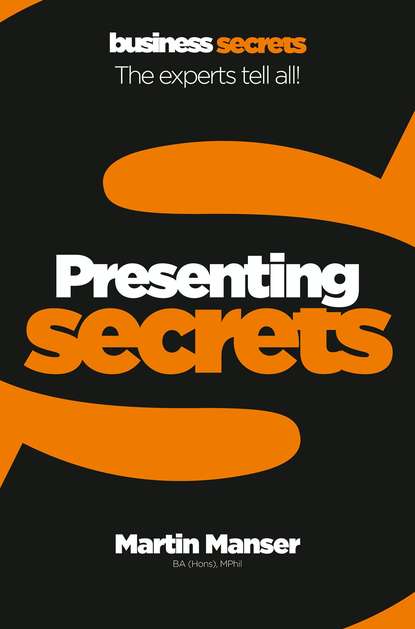По всем вопросам обращайтесь на: info@litportal.ru
(©) 2003-2025.
✖
Presenting
Автор
Год написания книги
2019
Настройки чтения
Размер шрифта
Высота строк
Поля
5.4 Less is more (#litres_trial_promo)
5.5 Remember, remember (#litres_trial_promo)
5.6 Listen carefully (#litres_trial_promo)
Be aware of body language (#litres_trial_promo)
6.1 Dress for success (#litres_trial_promo)
6.2 Stand up and be counted (#litres_trial_promo)
6.3 Keep eye contact with your audience (#litres_trial_promo)
6.4 Control your voice (#litres_trial_promo)
6.5 Pause for thought (#litres_trial_promo)
6.6 Make a move (#litres_trial_promo)
Learn from feedback (#litres_trial_promo)
7.1 Know when to take questions (#litres_trial_promo)
7.2 Answer questions well (#litres_trial_promo)
7.3 Deal respectfully with hostile questions (#litres_trial_promo)
7.4 Have a focused discussion of your presentation (#litres_trial_promo)
7.5 Evaluate your presentation (#litres_trial_promo)
7.6 Learn from your mistakes (#litres_trial_promo)
7.7 Excel in presenting (#litres_trial_promo)
Jargon buster (#litres_trial_promo)
Further reading (#litres_trial_promo)
About The Author (#litres_trial_promo)
Copyright (#litres_trial_promo)
About the Publisher (#litres_trial_promo)
Author’s note (#ulink_7c922ac1-7312-5cf0-9349-0df3e9bd6ff6)
Thank you to Alfred Biehler, Michael and Jeanette Hulcoop, Tim Duffy, Hannah and Brian Murphy.
Learn how to give the perfect presentation (#ulink_779a63bd-3971-5b72-87e6-d658b7e80d97)
We give presentations to provide information, explain something, present choices, sell a product or service, or persuade others to follow a course of action. Unfortunately, presentations can be dull. But yours doesn’t have to be. I’ve written this book to guide you through every step of the preparation so that your presentation communicates your message effectively and is successful.
My natural temperament is to be shy. Being the youngest of four children meant that I was a listener and generally kept my thoughts to myself. Gradually over the years I’ve come out of my shell and had the courage to express myself. Actually, it’s been a long and at times difficult struggle – and at times I’ve wanted to say something in a larger group but haven’t been brave enough to do so.
I’ve been giving presentations on various subjects for many years now and have gradually become less nervous and more confident. So I want to share with you some of the tips, hints and techniques that I’ve learnt the hard way.
This book consists of 50 secrets of giving good presentations, divided into seven chapters:
• Prepare the basics. If you have a clear idea of your audience and what you want to tell them, you are already on the way to success.
• Work on your words. You need to spend time refining your key messages to make sure they are clear.
• Plan for props and other people. Good use of visual aids can make a huge impact. A picture really can speak a thousand words.
• Prepare your mind. Positive thinking makes a positive difference. It’s normal to be nervous; you don’t need to be afraid of fear.
• Interact with your audience. Remember you’re giving a presentation, not a speech. An effective dialogue with the audience will ensure that you are giving them what they want.
• Be aware of body language. Research has shown that body language is an important factor in a successful presentation.
• Learn from feedback. Whether you are an experienced presenter or a first-timer, there is always more to learn.
If you follow these 50 secrets, you will know everything you need to deliver a brilliant presentation. Your audience will remember your message and, just as importantly, they will remember you.
Whether you are an experienced presenter or a first-timer, you can make a positive impact on your audience and, just as importantly, enjoy doing so!
Prepare the basics (#ulink_3833d610-acc7-5dea-82cd-73d36ad2472b)
The success of your presentation will depend on preparation. This chapter explains the firm foundations you need to lay to make your presentation effective. It covers creative thinking, organizing your thoughts and undertaking research. This is the ‘blank canvas’ stage. You need to work through the ultimate aims of what you are planning to achieve. Think about who is in your audience and the best way to communicate with them.
1.1 Stand out from the crowd (#ulink_32b6739b-77f4-57cf-a9c2-03bc06165177)
First of all, take a step back from thinking about the content of your presentation and think about your own personality instead. Remember that your audience will be listening to and looking at a presenter as much as a presentation.
You don’t want simply to deliver a series of data and facts. You want to put your soul into this presentation, and enjoy yourself in the process. The most interesting, memorable and effective presentations have the personality of their presenter stamped all over them. You want to put across your values and opinions, and your audience wants to hear them. Here are some tips to help you from the start to develop a really positive, creative view of yourself as an interesting presenter:
• Read something worthy. Devour your favourite website. Read a quality newspaper e.g. The Economist, Time, Newsweek.
• Think. Don’t just read. Think through the big underlying issues. Schedule in time to relax your brain from concentrated action. Carry a pen and notebook with you, or digital equivalents. Jot down your thoughts and ideas – however odd they may be. They may be useful.
“Don’t measure yourself by what you have accomplished, but by what you should have accomplished with your ability”
John Wooden, legendary basketball coach
• Really listen to people. What they’re saying…and not saying. Reflect on what you’re learning. Talk with friends and colleagues. Discuss issues and ideas; express your latest thinking to gauge responses. Develop ideas you feel passionate about.
• Examine your values and principles. What motivates you? Life is full of decisions. What spurs you on?












